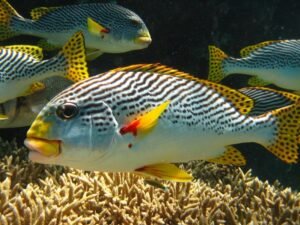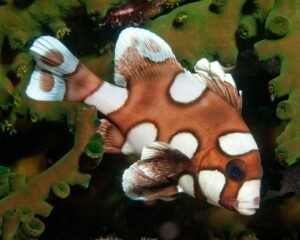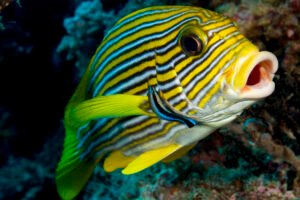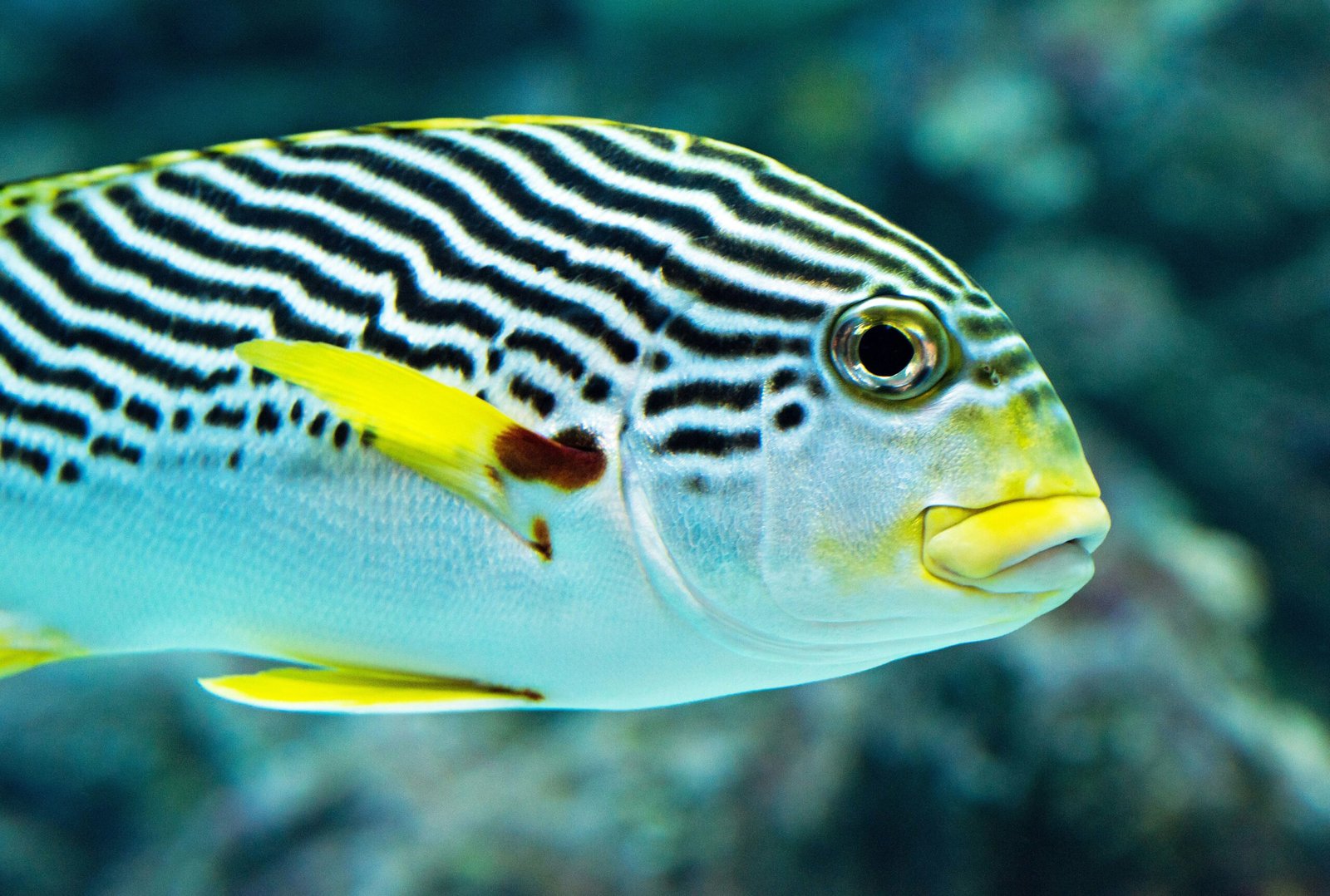World of Sweetlips fish
Sweetlips fish, belonging to the family Haemulidae, are an intriguing group of fish renowned for their vibrant and varied appearances. These marine creatures are particularly celebrated for their striking, colorful patterns, which make them a popular subject of interest among marine biologists and aquarium enthusiasts alike. Their name, Sweetlips, originates from the fish’s thick, fleshy lips, which are a distinguishing feature and play a role in their feeding habits.
The Fascinating World of Sweetlips exhibit a wide range of colors and patterns, from bright yellows and oranges to deep blues and blacks, often adorned with spots, stripes, or other intricate designs. This diversity in appearance not only aids in their identification but also serves various ecological functions, such as camouflage and communication within their species. Their distinctive look is a result of their adaptation to different marine environments, contributing to their survival and evolutionary success.
These fish are typically found in warm, tropical waters, thriving in coral reefs where they can find ample food and shelter. Their behavior is equally fascinating, as they exhibit unique social structures and have specific breeding habits that ensure the continuation of their species. The Sweetlips’ diet is diverse, consisting mainly of small invertebrates and crustaceans, which they skillfully hunt using their well-adapted mouths.
The study of Sweetlips not only enhances our understanding of marine biodiversity but also underscores the importance of conserving their natural habitats. As we delve deeper into the world of Sweetlips, we will explore their habitat, breeding habits, diet, and lifespan, unraveling the complexities of their existence and the ecological roles they play in their environments.
Natural Habitat of Sweetlips
Sweetlips, a popular species among marine enthusiasts, thrive predominantly in tropical and subtropical regions across the globe. The geographical distribution of Sweetlips spans the Indo-Pacific, the Red Sea, and the eastern coasts of Africa, reaching as far as the shallow waters of the Great Barrier Reef and the Hawaiian Islands. These regions provide the optimal conditions that support the diverse life forms within which Sweetlips coexist.
A notable trait of Sweetlips is their preference for specific types of ecosystems, with coral reefs being at the top of the list. Coral reefs offer a complex, structured habitat that is rich in food resources and provides ample hiding spots from predators. In addition to coral reefs, Sweetlips are also commonly found in lagoons, where the calmer waters and abundant vegetation create a conducive environment for their survival. Rocky substrates, characterized by their rugged terrain and crevices, offer another suitable habitat, providing both shelter and foraging grounds.
Several environmental factors significantly influence the habitat preferences of Sweetlips. Water temperature is paramount, with these fish favoring warm waters typically ranging from 22°C to 28°C. Depth also plays a crucial role; Sweetlips are often spotted at depths of 5 to 40 meters, although some species can venture deeper, adapting to the varying light and pressure conditions. Additionally, salinity levels are a critical consideration, as Sweetlips flourish in saline environments with stable salinity levels, which are characteristic of tropical and subtropical marine ecosystems.
Understanding the natural habitat of Sweetlips is essential for conservation efforts and for enthusiasts aiming to recreate these conditions in aquariums. By appreciating the geographical distribution, ecosystem preferences, and environmental factors that define their habitats, we can better support the thriving populations of these fascinating marine creatures.
Breeding Habits and Reproductive Behavior
Sweetlips exhibit fascinating breeding habits and reproductive behavior, which are integral to their survival and propagation. Their reproductive cycles are often synchronized with environmental cues, such as lunar cycles and water temperature, ensuring optimal conditions for the survival of their offspring. During the breeding season, Sweetlips engage in intricate courtship rituals that involve visual displays and physical interactions, aimed at attracting mates and establishing reproductive bonds.
The spawning process of Sweetlips typically occurs in group settings, where multiple pairs release their eggs and sperm simultaneously into the water column. This coordinated spawning increases the likelihood of fertilization and helps protect the eggs from predators through sheer numbers. The timing of these events is crucial, as it maximizes the chances of the eggs developing in conditions that support their growth and reduces the risk of predation.
Once fertilization occurs, Sweetlips exhibit varying degrees of parental care, depending on the species. In some cases, males take on the primary role of guarding and aerating the eggs to ensure they remain healthy and free from debris. Females, on the other hand, may focus on foraging to maintain their energy levels for future reproductive cycles. This division of labor enhances the survival rate of the eggs, as both parents contribute to the protection and nurturing of their progeny.
Despite their meticulous breeding strategies, Sweetlips face numerous challenges in their reproductive efforts. Predation by other marine species poses a significant threat to both eggs and juvenile fish. Environmental changes, such as fluctuations in water temperature and pollution, can also impact reproductive success. These external pressures necessitate adaptive behaviors and highlight the resilience of Sweetlips in maintaining their populations.
Understanding the breeding habits and reproductive behavior of Sweetlips provides valuable insights into their life cycle and the ecological factors that influence their survival. By studying these aspects, researchers can develop conservation strategies to protect these remarkable fish and ensure their continued presence in marine ecosystems.
Diet and Feeding Patterns
Sweetlips are known for their diverse and adaptable diet, consisting primarily of small crustaceans, mollusks, and various other invertebrates. These fish exhibit a remarkable ability to forage in different environments, making them effective predators in their respective habitats. The primary food sources for Sweetlips include shrimp, crabs, and small bivalves, which they expertly extract from crevices and sandy substrates using their specialized mouthparts.
Sweetlips possess a unique feeding technique that involves the use of their thick, fleshy lips to sift through sediment and capture prey. This specialized adaptation allows them to efficiently separate edible items from non-edible particles. Their strong jaws and teeth further assist in crushing the hard shells of crustaceans and mollusks, making it easier for them to consume their prey.
In various habitats, Sweetlips adapt their diet based on the available food sources. For instance, in coral reef environments, they may feed more on reef-associated invertebrates, while in sandy or muddy bottoms, they might focus on burrowing organisms. This dietary flexibility ensures their survival in diverse ecological niches, allowing them to thrive in both shallow coastal waters and deeper offshore environments.
Age also plays a significant role in the diet of Sweetlips. Juvenile Sweetlips often consume smaller prey items, such as tiny crustaceans and plankton, as their developing mouths and teeth are not yet suited for larger, harder-shelled organisms. As they grow and mature, their diet shifts to include larger and more challenging prey, reflecting their enhanced physical capabilities.
Overall, the diet and feeding patterns of Sweetlips highlight their adaptability and specialized foraging techniques. This resilience in their dietary habits not only supports their survival but also underscores their role as important predators within their ecosystems. Their ability to efficiently exploit a wide range of food sources makes them a fascinating subject of study for marine biologists and enthusiasts alike.
Lifespan and Growth Stages
Sweetlips, a distinctive family of reef fish, exhibit a fascinating lifecycle that spans several growth stages, each marked by unique physical and behavioral transformations. The journey begins as larvae, emerging from eggs in a pelagic environment. During the larval stage, Sweetlips are particularly vulnerable, relying on plankton for sustenance. As they develop into juveniles, they migrate towards coral reefs, where they find better protection and more abundant food sources.
The juvenile stage is characterized by rapid growth and strikingly different coloration patterns compared to adults. Juvenile Sweetlips often display bold, contrasting colors which fade as they mature. This change in appearance is believed to play a role in camouflage and predator avoidance. As they transition to sub-adults, their diet diversifies to include a variety of crustaceans, mollusks, and small fish, supporting further growth and development.
Reaching adulthood, Sweetlips exhibit more subdued coloration, which helps them blend into the reef environment. Adult Sweetlips are typically solitary or form small groups, displaying territorial behaviors and refined feeding techniques. The average lifespan of Sweetlips ranges from 10 to 15 years, although this can vary based on species and environmental conditions.
Several factors influence the longevity of Sweetlips. Predation remains a significant threat, particularly during the early stages of their lifecycle. Additionally, disease and parasites can impact their health and survival. Environmental conditions, such as water quality, temperature, and habitat availability, also play a crucial role in determining their lifespan. Adverse conditions can lead to stress and reduced immunity, making Sweetlips more susceptible to illness and predation.
Throughout their lives, Sweetlips undergo notable behavioral changes. Their feeding habits evolve from planktonic consumption as larvae to more complex hunting strategies as adults. Social behaviors also shift, with adults showing more defined territoriality and mating rituals. Understanding these growth stages and their associated challenges provides valuable insights into the biology and ecology of Sweetlips, highlighting the intricate balance of factors that contribute to their survival and longevity.
Role in the Ecosystem
Sweetlips are integral components of their natural habitats, playing vital roles in the marine ecosystem. As mid-level predators, they occupy a significant position in the food chain. Sweetlips primarily feed on invertebrates, such as crustaceans and mollusks, and small fish. This predatory behavior helps regulate the population of these organisms, preventing overpopulation and maintaining ecological balance. Their feeding habits also contribute to the health of coral reefs by controlling the abundance of certain species that could otherwise become destructive to the reef structure.
In turn, Sweetlips serve as prey for larger predators, including sharks and larger fish species. This prey-predator dynamic is essential for sustaining the biodiversity of marine life. By being a food source for larger predators, Sweetlips support the energy transfer within the ecosystem, ensuring that the nutrient cycle continues effectively. Their presence contributes to the complex web of interactions that sustain the health of coral reef environments.
Additionally, Sweetlips often engage in symbiotic relationships with other marine species. For instance, they can be seen participating in cleaning stations where cleaner fish, such as wrasses, remove parasites and dead skin from their bodies. This mutualistic interaction is beneficial for both parties; Sweetlips receive health benefits from being cleaned, while the cleaner fish gain a reliable food source. Such relationships highlight the interconnectedness of marine life and underscore the importance of each species in maintaining ecological stability.
Overall, Sweetlips play a multifaceted role within their ecosystems. They help balance the populations of various marine organisms, support the food web, and engage in symbiotic relationships that enhance the health and resilience of coral reef environments. Their ecological importance underscores the need for their conservation and the protection of their natural habitats.
Conservation Status and Threats
The conservation status of Sweetlips, a group of fish known for their striking patterns and colors, varies significantly among different species. While some Sweetlips species enjoy stable populations, others are facing considerable threats that have led to their classification as vulnerable or even endangered. The International Union for Conservation of Nature (IUCN) has listed several species within the Sweetlips family on its Red List, indicating varying degrees of concern regarding their sustainability.
One of the primary threats to Sweetlips populations is overfishing. These fish are highly sought after for both commercial and recreational purposes, which has led to significant declines in their numbers in certain regions. Overfishing not only reduces the population but also disrupts the ecological balance of their habitats, as Sweetlips play a crucial role in the marine food web.
Habitat destruction is another significant threat to Sweetlips. Coral reefs, which serve as a primary habitat for many Sweetlips species, are increasingly being damaged by human activities such as coastal development, pollution, and destructive fishing practices like blast fishing. The degradation of coral reefs not only affects the Sweetlips but also impacts the broader marine ecosystem that relies on these structures for survival.
Climate change poses a long-term threat to Sweetlips as well. Rising sea temperatures and ocean acidification have led to coral bleaching events, which severely damage the coral reefs that many Sweetlips species depend on. Additionally, changes in sea levels and water quality can alter the habitats and breeding grounds of these fish, further threatening their populations.
In response to these threats, various conservation efforts and protective measures have been implemented. Marine protected areas (MPAs) have been established in several regions to provide safe havens for Sweetlips and other marine life. These MPAs restrict certain human activities, thereby reducing overfishing and habitat destruction. Furthermore, initiatives aimed at coral reef restoration and sustainable fishing practices are being promoted to help mitigate the impacts of climate change and human activity on Sweetlips populations.
Continued research and monitoring are essential to effectively manage and protect Sweetlips species. By understanding their population dynamics, habitat requirements, and the specific threats they face, conservationists can develop more targeted and effective strategies to ensure the long-term survival of these fascinating fish.
Conclusion and Future Outlook
The Sweetlips fish, with their vibrant colors and intricate patterns, continue to captivate marine enthusiasts and researchers alike. Throughout this blog post, we have explored various aspects of Sweetlips, delving into their unique habitat preferences, intricate breeding habits, diverse diet, and notable lifespan. These insights not only enhance our understanding of Sweetlips but also underscore the importance of preserving these remarkable creatures and their habitats.
Understanding the habitat of Sweetlips is crucial for their conservation. These fish thrive in coral reefs, which are increasingly threatened by human activities such as overfishing, pollution, and climate change. By protecting coral reefs, we inherently safeguard the homes of Sweetlips and countless other marine species. Furthermore, understanding their breeding habits provides valuable data for developing effective conservation strategies. Knowing when and where Sweetlips breed can help in establishing marine protected areas that ensure the survival of future generations.
Diet is another critical aspect that influences the health and longevity of Sweetlips. By studying their dietary needs, we can ensure that their natural food sources are preserved, avoiding disruptions in the marine food web. Protecting the ecosystems that support these food sources is vital for maintaining the balance and health of the marine environment.
As we look to the future, ongoing and potential conservation initiatives offer hope. Efforts such as coral reef restoration, sustainable fishing practices, and pollution control are pivotal in ensuring the survival of Sweetlips. Public awareness and involvement are equally essential. By educating communities and encouraging sustainable practices, we can foster a collective effort to protect these fascinating fish.
In conclusion, the future of Sweetlips depends on our actions today. By understanding their needs and addressing the threats they face, we can contribute to their preservation. Let us be inspired to appreciate and protect the world of Sweetlips, ensuring that they continue to thrive for generations to come.
